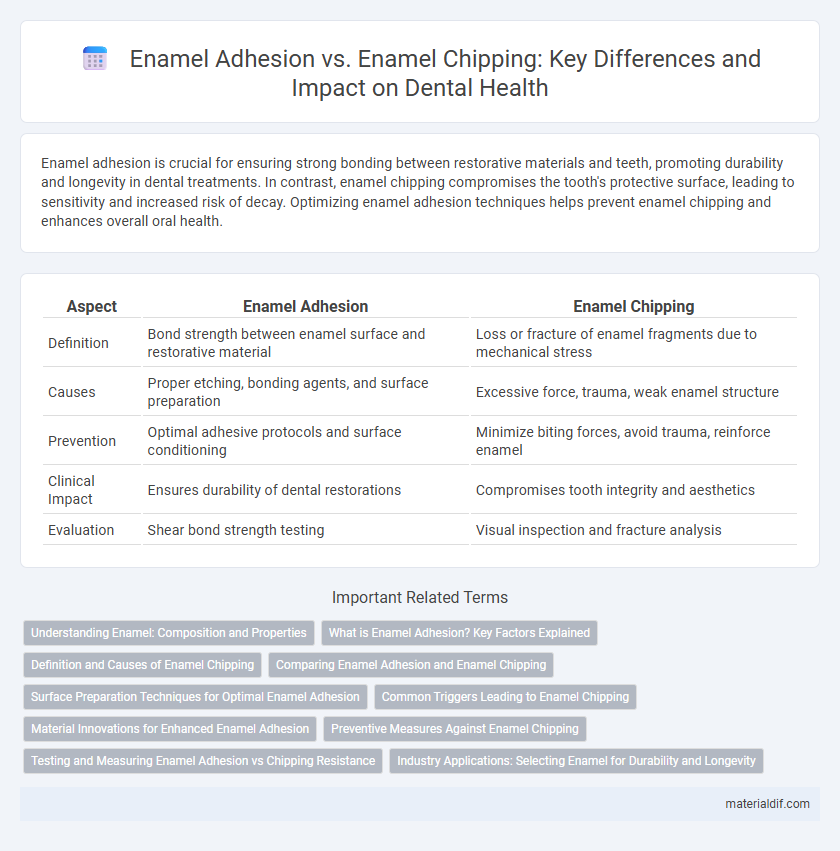Enamel adhesion is crucial for ensuring strong bonding between restorative materials and teeth, promoting durability and longevity in dental treatments. In contrast, enamel chipping compromises the tooth's protective surface, leading to sensitivity and increased risk of decay. Optimizing enamel adhesion techniques helps prevent enamel chipping and enhances overall oral health.
Table of Comparison
| Aspect | Enamel Adhesion | Enamel Chipping |
|---|---|---|
| Definition | Bond strength between enamel surface and restorative material | Loss or fracture of enamel fragments due to mechanical stress |
| Causes | Proper etching, bonding agents, and surface preparation | Excessive force, trauma, weak enamel structure |
| Prevention | Optimal adhesive protocols and surface conditioning | Minimize biting forces, avoid trauma, reinforce enamel |
| Clinical Impact | Ensures durability of dental restorations | Compromises tooth integrity and aesthetics |
| Evaluation | Shear bond strength testing | Visual inspection and fracture analysis |
Understanding Enamel: Composition and Properties
Enamel adhesion relies on the enamel's highly mineralized structure, composed primarily of hydroxyapatite crystals, which provide a rigid and durable surface for bonding agents. The enamel's prismatic arrangement enhances mechanical retention but increases susceptibility to chipping if excessive stress is applied during restorative procedures. Understanding the crystalline orientation and hardness of enamel is essential for optimizing adhesion techniques while minimizing the risk of enamel chipping in dental treatments.
What is Enamel Adhesion? Key Factors Explained
Enamel adhesion refers to the ability of dental materials, such as bonding agents or veneers, to chemically and mechanically bond to the enamel surface, ensuring durability and stability. Key factors influencing enamel adhesion include the enamel's microstructure, surface preparation through etching, and the type of adhesive system used, which collectively affect bonding strength and longevity. Proper enamel adhesion is crucial to prevent enamel chipping, as insufficient bonding can lead to restoration failure and increased risk of enamel damage under stress.
Definition and Causes of Enamel Chipping
Enamel chipping refers to the fracture or loss of enamel fragments from the tooth surface, often caused by trauma, biting on hard objects, or weakened enamel structure due to acid erosion or demineralization. Enamel adhesion involves bonding restorative materials to the enamel surface to repair damage and restore function, relying on micromechanical retention and chemical bonding to achieve strong attachment. The main causes of enamel chipping include excessive mechanical stress, enamel hypoplasia, bruxism, and exposure to acidic environments that compromise enamel integrity.
Comparing Enamel Adhesion and Enamel Chipping
Enamel adhesion involves strong bonding of restorative materials to the tooth surface, critical for long-lasting dental restorations, while enamel chipping refers to the breakage or loss of enamel fragments, often caused by mechanical stress or trauma. Effective adhesion depends on surface conditioning techniques such as acid etching, which enhances micromechanical retention and reduces the risk of restoration failure. In contrast, enamel chipping compromises tooth integrity and may require repair or replacement to restore function and aesthetics.
Surface Preparation Techniques for Optimal Enamel Adhesion
Effective surface preparation techniques significantly enhance enamel adhesion by creating a microscopically roughened surface that promotes mechanical interlocking. Methods such as acid etching with phosphoric acid and sandblasting increase surface energy and remove contaminants, preventing enamel chipping during application. Optimizing enamel adhesion through these techniques ensures durability and resistance to wear in dental and industrial coatings.
Common Triggers Leading to Enamel Chipping
Enamel adhesion failure often occurs due to improper bonding techniques or surface contamination, weakening the interface between enamel and restorative materials. Common triggers leading to enamel chipping include excessive occlusal forces, sudden impact trauma, and enamel brittleness caused by acid erosion or demineralization. Understanding these factors is crucial for improving restorative longevity and minimizing enamel damage in dental treatments.
Material Innovations for Enhanced Enamel Adhesion
Material innovations in enamel adhesion focus on advanced bonding agents that improve the interface strength between enamel and substrates, reducing the risk of enamel chipping during mechanical stress. Nanotechnology-enhanced adhesives and surface treatments increase microscale surface roughness, promoting stronger chemical and physical bonds. These innovations lead to longer-lasting enamel coatings with superior resistance to chipping and wear in dental and industrial applications.
Preventive Measures Against Enamel Chipping
Preventive measures against enamel chipping center on maintaining strong enamel adhesion by minimizing exposure to acidic foods and abrasive brushing techniques that weaken enamel integrity. Using fluoride-rich dental products enhances enamel remineralization, thereby reducing the likelihood of microfractures that lead to chipping. Regular dental check-ups enable early detection of enamel erosion, improving the effectiveness of targeted treatments that preserve enamel adhesion and prevent chip formation.
Testing and Measuring Enamel Adhesion vs Chipping Resistance
Testing enamel adhesion involves measuring the bond strength between enamel and restorative materials using shear or tensile bond strength tests, which assess the durability of the enamel-restoration interface. Chipping resistance evaluation focuses on quantifying the enamel's ability to withstand mechanical forces, typically through flexural strength tests or fracture toughness measurements that simulate real-life stress conditions. Accurate assessment of both adhesion and chipping resistance is essential for predicting enamel performance and optimizing restorative dental materials.
Industry Applications: Selecting Enamel for Durability and Longevity
Enamel adhesion plays a critical role in preventing enamel chipping, especially in industries such as automotive, cookware, and architectural coatings where durability is paramount. Selecting enamel formulations with superior bonding properties enhances resistance to mechanical stress, thermal cycling, and chemical exposure, thereby extending product lifespan. Optimal adhesion reduces maintenance costs and improves overall performance in high-wear environments, aligning with industry standards for long-term reliability.
Enamel adhesion vs enamel chipping Infographic

 materialdif.com
materialdif.com